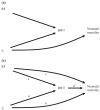Quantification of collider-stratification bias and the birthweight paradox
- PMID: 19689488
- PMCID: PMC2743120
- DOI: 10.1111/j.1365-3016.2009.01053.x
Quantification of collider-stratification bias and the birthweight paradox
Abstract
The 'birthweight paradox' describes the phenomenon whereby birthweight-specific mortality curves cross when stratified on other exposures, most notably cigarette smoking. The paradox has been noted widely in the literature and numerous explanations and corrections have been suggested. Recently, causal diagrams have been used to illustrate the possibility for collider-stratification bias in models adjusting for birthweight. When two variables share a common effect, stratification on the variable representing that effect induces a statistical relation between otherwise independent factors. This bias has been proposed to explain the birthweight paradox. Causal diagrams may illustrate sources of bias, but are limited to describing qualitative effects. In this paper, we provide causal diagrams that illustrate the birthweight paradox and use a simulation study to quantify the collider-stratification bias under a range of circumstances. Considered circumstances include exposures with and without direct effects on neonatal mortality, as well as with and without indirect effects acting through birthweight on neonatal mortality. The results of these simulations illustrate that when the birthweight-mortality relation is subject to substantial uncontrolled confounding, the bias on estimates of effect adjusted for birthweight may be sufficient to yield opposite causal conclusions, i.e. a factor that poses increased risk appears protective. Effects on stratum-specific birthweight-mortality curves were considered to illustrate the connection between collider-stratification bias and the crossing of the curves. The simulations demonstrate the conditions necessary to give rise to empirical evidence of the paradox.
Figures


Comment in
-
Commentary: biology vs. methodology in investigating causal pathways for infant mortality.Paediatr Perinat Epidemiol. 2009 Sep;23(5):414-6; author reply 421-3. doi: 10.1111/j.1365-3016.2009.01050.x. Paediatr Perinat Epidemiol. 2009. PMID: 19689490 No abstract available.
-
Commentary: exegesis of effect modification - biological or spurious?Paediatr Perinat Epidemiol. 2009 Sep;23(5):417-20; author reply 421-3. doi: 10.1111/j.1365-3016.2009.01051.x. Paediatr Perinat Epidemiol. 2009. PMID: 19689491 No abstract available.
References
-
- Wilcox AJ. Commentary: on the paradoxes of birthweight. International Journal of Epidemiology. 2003;32:632–633. - PubMed
-
- Wilcox AJ. On the importance - and the unimportance - of birthweight. International Journal of Epidemiology. 2001;30:1233–1241. - PubMed
-
- Wilcox AJ, Russell IT. Birthweight and perinatal mortality: III. Towards a new method of analysis. International Journal of Epidemiology. 1986;15:188–196. - PubMed
-
- Wilcox AJ, Russell IT. Perinatal mortality: standardizing for birthweight is biased. American Journal of Epidemiology. 1983;118:857–864. - PubMed
-
- Wilcox AJ, Russell IT. Birthweight and perinatal mortality: II. On weight-specific mortality. International Journal of Epidemiology. 1983;12:319–325. - PubMed
Publication types
MeSH terms
Grants and funding
LinkOut - more resources
Full Text Sources
Medical

